
Sprint Broadband Cards & Mobile Hotspots
The Sprint / Sierra Overdrive Mobile Hotspot offers up unlimited mobile broadband in 4G coverage areas for $60/month. When the faster 4G network isn’t available, you’ll have the standard 5 GB of data in 3G areas.
At just a bit longer than a AA Energizer battery on each side, it’s small enough to fit in your hand, pocket or laptop carrying case.
Sprint’s promo video for the Sierra Overdrive Mobile Hotspot
Stuff You Should Know (Good & Bad)
Design
The Sierra Overdrive was built for portability. At 4.5 ounces, it’s as about the weight of 5 stacked quarters and smaller than an iPhone or Blackberry.
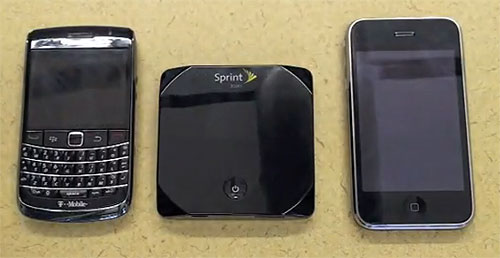
If a phone can fit in your hand or pocket, then the Overdrive definitely can.
In a welcome departure from previous mobile hotspots, the Overdrive has an LCD screen that displays useful info:

- Signal strength
- 3G/4G status
- Roaming status
- GPS availibility
- Number of Wi-Fi users
- Battery level
- Data transferred
- How long it’s been active
Features
Summary:
- Sprint 3G EVDO, WiMAX 2500 MHz / WiFi Route
- Integrated GPS
- 128 × 228 pixels, 1.4″ monochrome LCD
- micro-USB port (charging and tethering)
- microSD card slot (up to 16 GB)
- 1830 mAh battery (3 hour battery life / 36 hours standby)
- Dimensions: 3.14 x 3.14 x 0.61″ and 4.51 ounces
- WiFi range up to 150 feet
- WiFi security options include: WEP, WPA Personal (TKIP/AES), WPA2 Personal (AES & AES/TKIP available)
Naturally, the Overdrive’s biggest feature is its ability to broadcast 3G/4G connections (up to 150 feet). Since it’s a real WiFi connection and not an adhoc network, any WiFi-enabled device can connect to its password-protected network.

As a backup, you can connect via USB to charge while continuing to use the wireless connection. Since the battery life is about 3 hours (1.5 if streaming video), this might not be ideal for long roadtrips unless you’ve got a USB port in your car handy for charging. As a point of interest, the MiFi’s battery life is 4 hours.
If you’d prefer to not broadcast for security reasons, you can enter a tethered mode. If doing so, note that only Windows 7, Windows Vista, Windows XP, or Mac (OS X 10.4.x or higher) are officially supported.
Another cool option is shared microSD storage.
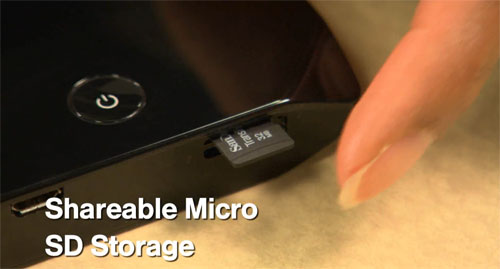
With support for up to 16 Gigabytes of microSD storage, you can share any file over the WiFi network easily. If RV’ing across the country with the entire family, up to 5 people could watch completely different movies or flip through photos all from the same microSD card.
Using microSD cards larger than 16 GB can cause data loss and damage the Sierra Overdrive.
Get a bit closer to the Sierra Overdrive in this Boy Genius Report video review.
What’s Speed & Coverage Like?
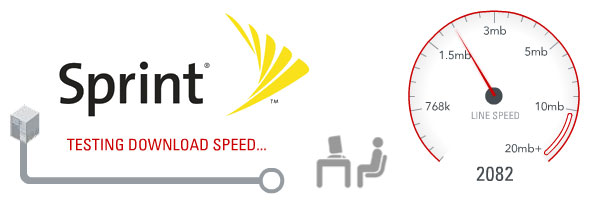
The Sierra Overdrive is available from Sprint for use with their 3G and 4G networks. Here’s a synopsis of what to expect with speed and coverage:
| Mobile Broadband Provider | |
| Speed | |
| Advertised Download Speed | 600 Kbps – 1.4 Mbps (3G) 3 – 6 Mbps (4G) |
| Real (Tested) Download Speed | 600 Kbps – 1.4 Mbps (3G)
3 – 6 Mbps (4G) |
| Advertised Upload Speed | 350 Kbps – 500 Kbps (3G) 1 Mbps (4G) |
| Real (Tested) Upload Speed | 250 Kbps – 425 Kbps (3G)
Up to 1 Mbps (4G) |
| Coverage | |
| Regional or National? | National (3G) Regional (4G) Check Coverage |
Since Sprint’s 4G network is currently available in select markets, be sure to check out the 4G coverage review to see if you’re covered. If not, you’ll be using their 3G network which limits you to 5 Gigabytes per month.
If you’ll be using Sprint’s 3G network, you’ll definitely want to read “How Much is 5GB & Is It Enough” to avoid $51.20/GB overage charges.
On paper (or webpage rather), the Sierra Overdrive sounds ideal. Besides replacing your DSL or cable connection, Sprint offers up some scenarios for business use:
- Real estate agents can conduct virtual property tours.
- Construction teams using 4G in the field can save valuable time by sharing schematics with engineers online.
- Insurance companies can speed their claims management through real-time communication with on-site adjusters.
- Health care professionals can improve their ability to remotely monitor patients.
- Emergency first responders can rapidly assess and coordinate disaster action with real-time on-site video and audio.
- Photojournalists can instantly transfer high-resolution images to the newsroom.
While this is quite practical, the Sierra Overdrive isn’t without fault:
Unfortunately, the 4G performance is not nearly as stable [as 3G performance]. For one, in our extensive tests the speeds the Overdrive provided when connecting to 4G were not equal to what we saw with other 4G devices connected to the exact same tower in the same location.
The good news is that this problem does not seem to be effecting everyone (it may even be location-based), and as mentioned, we have confirmed that Sierra has a fix on the way for this problem.
Even more disconcerting than the speed issues is the fact that (for some users, not all) the Overdrive intermittently refuses to connect to 4G at all, displaying mysterious error codes on the LCD screen – error codes that even Sprint has no reference for!
– via EVDOInfo
So Is It A Keeper?
Yes.
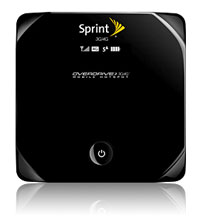 Since it’s not guaranteed you’ll have this issue and if you do there’s a fix that is already in the works, I say take the plunge and grab it even if you are not in a 4G area.
Since it’s not guaranteed you’ll have this issue and if you do there’s a fix that is already in the works, I say take the plunge and grab it even if you are not in a 4G area.
Since Sprint will be rolling out 4G over many markets, there’s a good chance it might become available to you over the course of your 2-year contract. Think of it as future-proofing.
While I’m not in a 4G market at the moment, I plan to pick one up when I do for the simple fact that I like the convenience of a mobile hotspot that travels with me.
Since life doesn’t stop for anything, why should your internet connection?
Nab the Sierra Overdrive for $40 (aff link) or compare it another Sprint Broadband Card or Mobile Hotspot here.
Related:
Sprint MiFi 2200 Mobile Hotspot Review
2010 Sprint Broadband Cards & Mobile Hotspots
2010 Broadband Card Comparison

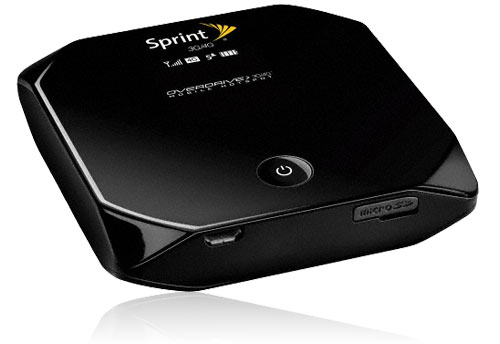
G. Ellisberg says:
Connections are unreliable and the battery overheats and swells constantly. As for Sprint… they lie and obfuscate after the sale when hordes of Overdrive users try to have their swollen batteries replaced. No concept of customer service whatsoever. Deceptive billing practices for some (I have not experienced them). Look in the Sprint “Support” forums. After a year, most of them are without a single helpful comment from Sprint. Customers are beginning to talk class action lawsuits because Sprint has been absolutely recalcitrant in helping these Overdrive users.
B Manzella says:
I was told I was in a 4 G area. I have had my overdrive and have a 900.00 bill because my unit switches back and forth from 4G to 3 G without knowing. Sprint will not help with my overages. It is just so crazy becasue I was told I was in a 4G area. I just don’t understand.